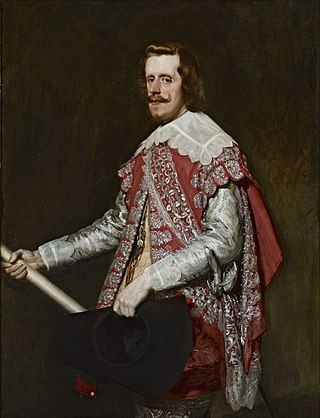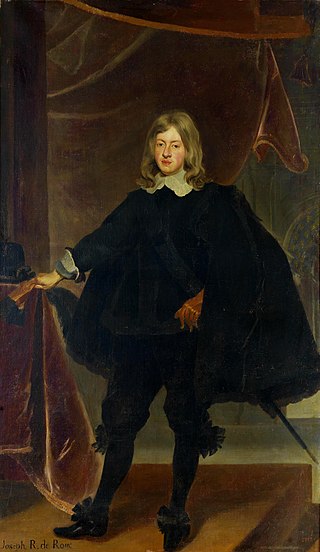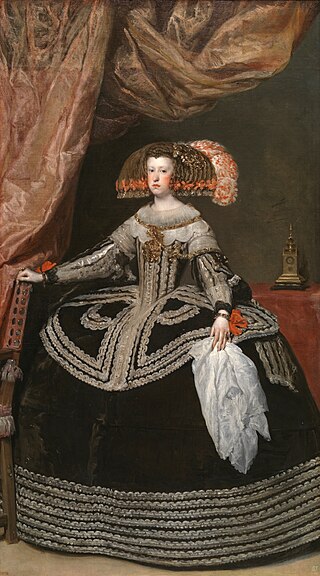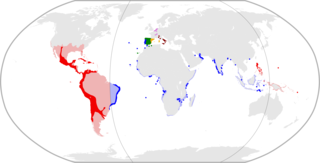| |||||
| Decades: | |||||
|---|---|---|---|---|---|
| See also: | Other events of 1633 List of years in Spain | ||||
This article needs additional citations for verification .(February 2024) |
Events from the year 1633 in Spain
| |||||
| Decades: | |||||
|---|---|---|---|---|---|
| See also: | Other events of 1633 List of years in Spain | ||||
This article needs additional citations for verification .(February 2024) |
Events from the year 1633 in Spain
| | This section needs expansion. You can help by adding to it. (October 2015) |
| | This section needs expansion. You can help by adding to it. (October 2015) |
| | This section needs expansion. You can help by adding to it. (October 2015) |

Philip IV, also called the Planet King, was King of Spain from 1621 to his death and King of Portugal from 1621 to 1640. Philip is remembered for his patronage of the arts, including such artists as Diego Velázquez, and his rule over Spain during the Thirty Years' War.

DomJohn IV, nicknamed John the Restorer, was the King of Portugal whose reign, lasting from 1640 until his death, began the Portuguese restoration of independence from Habsburg Spanish rule. His accession established the House of Braganza on the Portuguese throne, and marked the end of the 60-year-old Iberian Union by which Portugal and Spain shared the same monarch.

Ferdinand IV was made and crowned King of Bohemia in 1646, King of Hungary and Croatia in 1647, and King of the Romans on 31 May 1653. He also served as Duke of Cieszyn.

Mariana or Maria Anna of Austria, was Queen of Spain from 1649 until the death of her husband Philip IV of Spain in 1665. Appointed regent for their infant son Charles II, she remained an influential figure until her death in 1696.

Balthasar Charles, Prince of Asturias, Prince of Girona, Duke of Montblanc, Count of Cervera, and Lord of Balaguer, Prince of Viana was heir apparent to all the kingdoms, states and dominions of the Spanish monarchy from his birth until his death.

Don Rodrigo Pacheco y Osorio de Toledo, 3rd Marquess of Cerralvo was a Spanish nobleman, inquisitor of Valladolid, and viceroy of New Spain. He held the latter position from November 3, 1624 to September 16, 1635.

Don Lope Díez de Aux de Armendáriz, 1st Marquess of Cadreita was a Spanish nobleman and the first Criollo to be viceroy of New Spain. He served as viceroy from 16 September 1635 to 27 August 1640.

Gonzalo Fernández de Córdoba y Cardona-Anglesola was one of the main Spanish military leaders during the Eighty Years' War, Thirty Years' War, and the War of the Mantuan Succession.

Juan Cerezo de Salamanca was interim Spanish governor of the Philippines from August 2, 1633 to June 25, 1635.

Juan Bautista Martínez del Mazo was a Spanish Baroque portrait and landscape painter, the most distinguished of the followers of his father-in-law Velázquez, whose style he imitated more closely than did any other artist. A fine painter himself, Mazo was a master of landscape, as proven by his most celebrated work View of Saragossa.

The Jester Barbarroja is an oil on canvas portrait by Diego Velázquez of Cristóbal de Castañeda y Pernia, nicknamed Barbarroja in his role as a jester at the court of Philip IV of Spain from 1633 to 1649. The painting is now in the Museo del Prado. It was in the Palacio del Buen Retiro in Madrid in 1701, one of six portraits of court jesters in the Queen's quarters. From 1816 to 1827 it was in the Real Academia de Bellas Artes de San Fernando.
Luis Benedit y Horruytiner was a Spanish colonial administrator who held office as governor of Spanish Florida, and viceroy of Sardinia. He was the uncle of Pedro Benedit Horruytiner, who succeeded him as governor of La Florida.

Fernando Afán de Ribera y Téllez-Girón was a Spanish noble and diplomat.

Ana de Mendoza y Enríquez de Cabrera, was the 6th Duchess of the Infantado from 1601-1633.

Rodrigo Díaz de Vivar Mendoza y Sandoval, 7th Duke of the Infantado was a Spanish noble of the House of Mendoza and the 7th Duke of the Infantado. He was Viceroy of Sicily from 1651 to 1655.

The siege of Rheinfelden of 1633 or the Spanish recapture of Rheinfelden(Spanish: La Expugnación de Rheinfelden) took place in late October 1633, during the Thirty Years' War.
Jorge de Cárdenas y Manrique de Lara, 4th Duke of Maqueda and 6th Duke of Nájera, was a Spanish noble, military and statesman, born in Elche.
Ramiro Núñez de Guzmán, II Duke of Medina de las Torres, was a Spanish nobleman.

The Supreme Council of Flanders and Burgundy was a governing institution in the Spanish Empire responsible for advising the king of Spain on the exercise of his prerogatives in the Spanish Netherlands. This territory comprised most of the modern states of Belgium and Luxembourg, as well as parts of northern France, the southern Netherlands, and western Germany, particularly regarding ecclesiastical nominations, the appointment of high officials, royal pardons, and awards of honours such as knighthoods and noble titles.
![]() Media related to 1633 in Spain at Wikimedia Commons
Media related to 1633 in Spain at Wikimedia Commons